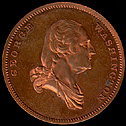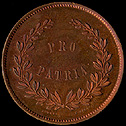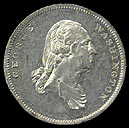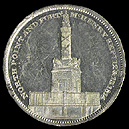Washington Medals 1850-59
obverse |
|
reverse |
| |||
Baker 268B Pro Patria First obverse, 1859 Lovett Philadelphia
Obverse: GEORGE WASHINGTON
Reverse: PRO / PATRIA [below oak wreath] LOVETT PHILA
Edge: Plain
Copper Weight: 178.0 g (11.54 grams) Diameter: 31.1 mm Reverse die alignment: 360°
Comments: The obverse shows a draped bust right of Washington while the reverse has the motto PRO PATRIA (For the Country) within an oak wreath, with the signature of the engraver Robert Lovett, Jr. of Philadelphia. The lower half of the right stroke of the A in PHILA is broken. This medal was made for the Philadelphia coin dealer Edward Cogan and was issued in silver, copper, bronze and white metal with all but the silver having both plain and reeded edge varieties.
This obverse was also used on Baker 324 (described in the following entry). According to Cogan the obverse die was stolen on December 14, 1859. Lovett then combined the PRO PATRIA reverse with a new (second) obverse having the legend GEORGE WASHINGTON above and SECURITY below the bust (Baker 269). Later Lovett used the PRO PATRIA reverse with a third obverse showing Washington on horseback (Baker 270).
Provenance: Part of an anonymous donation consisting of 1100 tokens and medals covering the Nineteenth century, primarily up through the Civil War era.
Reference: Rulau and Fuld, p. 120.
obverse |
|
reverse |
| |||
Baker 324C Baltimore battle monument [1859] Lovett Philadelphia
Obverse: GEORGE WASHINGTON
Reverse: NORTH POINT AND FORT McHENRY. SEPT. 12' & 13' 1814 [below at the bottom of the two larger lower panels on the front of the monument] LOVETT PHILA.
Edge: Reeded
White metal Weight: 141.8 g (9.19 grams) Diameter: 31.1 mm Reverse die alignment: 330°
Comments: This is an undated mule produced by Robert Lovett, Jr. in Philadelphia. The obverse is the draped bust right Washington of the PRO PATRIA medal shown above (Baker 268). It has been joined with a reverse depicting a monument commemorating the successful defence of Fort McHenry in Baltimore harbor against a British naval attack during the War of 1812 (this defence inspired Francis Scott Key to compose the national anthem, The Star Spangled Banner). The Baltimore monument was completed by the Italian sculptor André Causici in 1829 consisting of a full length sculpture of Washington in classical dress atop a column designed to represent a bundle of ancient roman fasces.
This undated medal has a beaded border and a reeded edge and was issued in silver, copper bronze and white metal (all have reeded edge varieties but the copper and white metal also have a few rare plain edge examples). According to Cogan the obverse die was stolen on December 14, 1859 so this medal, like the medal using this obverse mentioned in the preceding entry (Baker 268), can be dated to before December of 1859.
Provenance: Part of an anonymous donation consisting of 1100 tokens and medals covering the Nineteenth century, primarily up through the Civil War era.
References: Baker, pp. 136-137; Rulau and Fuld, p. 142 with the Cogan information on p. 120.
|
|
|
|
| 1850-59b3 | Section Contents | 1850-59d |



